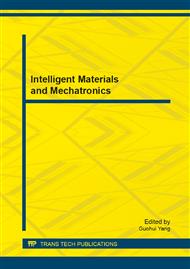[1]
Chen Long, Zhou Kongkang, Li Dechao. Study on Control Technology of Semi-active Suspension on a Vehicle[J]. Transactions of The Chinese Society of Agricultural Machinery, 2002, 33(1): 25-28 (In Chinese).
Google Scholar
[2]
Li Yinong, Zheng Ling. Research on Nonlinear Control Methods of Automotive Semi-active Suspension[J]. Transactions of The Chinese Society of Agricultural Machinery, 2005, 36(5): 9-15(In Chinese).
Google Scholar
[3]
Zhang Xiaozu, Wu Peng, Huang Shaohua. Performance Analysis of Vehicle Semi-active Suspension Based on Fuzzy and Robust Control Method[J]. Transactions of The Chinese Society of Agricultural Machinery, 2006, 37(5): 1-4(In Chinese).
Google Scholar
[4]
Cao Min, Yu Fan. Development of Magnetorheological Damper for Vehicle[J]. Chinese Journal of Mechanical Engineering, 2004, 40(3): 186-190(In Chinese).
DOI: 10.3901/jme.2004.03.186
Google Scholar
[5]
Liu Shaoqing Yao Bin Yuan Shanfa, et al. Fuzzy-PID Switch Control on Semi-active Suspensions with MR Damper[J]. Transactions of the Chinese Society for Agricultural Machinery, 2006, 37(12): 4-7(12) (In Chinese).
Google Scholar
[6]
Jia Yongshu, Zhou Kongkang. Rheological Properties Analysis and Experiment of Magnetorheological Fluid for Automobile[J]. Journal of Mechanical Engineering, 2009, 45(6): 246-250 (In Chinese).
DOI: 10.3901/jme.2009.06.246
Google Scholar
[7]
Zhao Yanshui, 2 Zhou Kongkang, Li Zhongxingcet al. Time Lag of Magnetorheological Damper Semi-active Suspensions[J]. Journal of Mechanical Engineering, 2009, 45(7): 221-227(In Chinese).
DOI: 10.3901/jme.2009.07.221
Google Scholar
[8]
D. E. Simon,. Experimental Evaluation of Semiactive Magnetorheological Primary Suspensions for Heavy Truck Applications[D]. Blacksburg, VA: Virginia Tech, p.5, September (1998).
Google Scholar
[9]
S. Ikenaga, F.L. Lewis, J. Campos, et al. Active Suspension Control of Ground Vehicle Based on a Full-Vehicle Model[C]. Proceedings of the American Control Conference Chicago, Illinois June 2000: 4019-4024.
DOI: 10.1109/acc.2000.876977
Google Scholar
[10]
S.B. Choi,. Performance Comparison of Vehicle Suspensions Featuring Two Different Electrorheological Shock Absorbers[C]. Proceeding of Institution of Mechanical Engineers, Vol. 217 Part D:J. Automobile Engineering 2000, 999-1010.
DOI: 10.1243/095440703770383893
Google Scholar
[11]
Chen Jieping, Chen Wuwei, Zhu Hui, et al. Design and Test of Vehicle Single Outstretch Pole MRD[J]. Transactions of The Chinese Society of Agricultural Machinery, 2009, 40(3): 5-10(In Chinese).
Google Scholar
[12]
M W. Sayers. Dynamic terrain inputs to predict structural integrity of ground vehicles [R]. Michigan: University of Michigan Transportation Research Institute Report UM TR I-88-16, (1988).
Google Scholar
[13]
Chen Jieping, Chen Wuwei, Zhu Hui, et al. Modeling and Simulation on Stochastic Road Surface Irregularity Based on Matlab/Simulink[J]. Transactions of The Chinese Society of Agricultural Machinery, 2010, 41(3): 11-15(In Chinese).
Google Scholar
[14]
D Karnopp, M J Crosby, R A Harwood. Vibration control using semi-active force generators[J]. ASME Journal of Engineering for Industry, 1974, 96(2): 619~626.
DOI: 10.1115/1.3438373
Google Scholar


